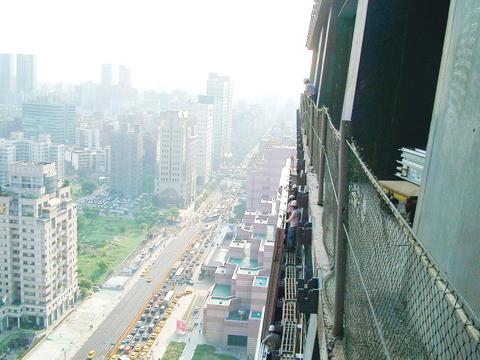The Taipei City Government has approved the resumption of construction on Taipei 101 -- formerly known as the Taipei Financial Center -- over three months after a powerful earthquake detached two tower cranes from their mounts, causing them to hurtle to the ground killing five people.
The Bureau of Labor Affairs and the Public Works Department of the city government issued the notice, permitting full resumption of construction on all floors on June 28 and July 3, respectively.

PHOTO: TAIPEI 101
Permission to resume building on floors from B5 to 23 was granted on May 15, although building restrictions have reportedly cost the company NT$800 million, which are expenses related to workers' wages, insurance premiums and other costs associated with keeping the project going. The figure does not include the cost of reparing the damage caused by the quake.
Construction was halted on March 31 when the earthquake, measuring 6.8 on the Richter scale, sent the two cranes perched on the 56th floor plummeting to earth.
According to Terry Shen (沈雲飛), vice president of the tower's builder -- the Taipei Financial Center Corp (台北金融大樓公司) -- two new cranes are being built in a joint venture between Japan's Nippon Steel and Taiwan's China Steel Corp (中鋼).
The new cranes, which will replace toppled cranes No. 2 and No. 4, will have specially reinforced masts that will be able to withstand strong quakes like the one on March 31, Shen said.
Shen said that the new cranes will have special pin-strengthened masts which are the same as those used in cranes in No. 1 and No. 3 -- which stayed in position during the earthquake.
"The pin-system is much stronger, as was seen during the quake when the other cranes didn't fall," Shen said.
The differences between the four cranes don't stop there. Cranes No. 1 and No. 3 were virtually custom-made for use on the project, while cranes No. 2 and No. 4 had already been used previously in Hong Kong, Shen said.
"The parts and elements are expected to arrive in mid-August and installation will begin in September. There will therefore be no significant progress on the steel structure above the 56th floor until September," according to a company statement.
The city government is currently examining reports submitted by Taipei Financial's main contractor, KTRT, on what caused the crane masts to fail during the temblor. KTRT is formed by Kumagai Gumi, Taiwan Kumagai, RSEA Engineering Corporation (
The report also includes a study of the accident and the safety of the building structure by the Taipei Structural Engineers Association and of tower crane enhancement, conducted by National Taiwan University's Center of Earthquake Engineering Research (CEER).
No decision has been made on whether professional misconduct or criminal negligence were factors in the tragedy.
Taipei 101 is scheduled for completion by 2004.
The biggest single shareholder in what is to be world's tallest building is China United Trust & Investment Corp (中聯信託) -- which has a 20 percent stake. The next leading shareholder is the China Development Industrial Bank (中華開發銀行). The most important anchor tenant of the facility will be the Taiwan Stock Exchange (證交所), which will occupy about seven floors in the building, or about 6,000 pings.

Shares in Taiwan closed at a new high yesterday, the first trading day of the new year, as contract chipmaker Taiwan Semiconductor Manufacturing Co (TSMC, 台積電) continued to break records amid an artificial intelligence (AI) boom, dealers said. The TAIEX closed up 386.21 points, or 1.33 percent, at 29,349.81, with turnover totaling NT$648.844 billion (US$20.65 billion). “Judging from a stronger Taiwan dollar against the US dollar, I think foreign institutional investors returned from the holidays and brought funds into the local market,” Concord Securities Co (康和證券) analyst Kerry Huang (黃志祺) said. “Foreign investors just rebuilt their positions with TSMC as their top target,

REVENUE PERFORMANCE: Cloud and network products, and electronic components saw strong increases, while smart consumer electronics and computing products fell Hon Hai Precision Industry Co (鴻海精密) yesterday posted 26.51 percent quarterly growth in revenue for last quarter to NT$2.6 trillion (US$82.44 billion), the strongest on record for the period and above expectations, but the company forecast a slight revenue dip this quarter due to seasonal factors. On an annual basis, revenue last quarter grew 22.07 percent, the company said. Analysts on average estimated about NT$2.4 trillion increase. Hon Hai, which assembles servers for Nvidia Corp and iPhones for Apple Inc, is expanding its capacity in the US, adding artificial intelligence (AI) server production in Wisconsin and Texas, where it operates established campuses. This

H200 CHIPS: A source said that Nvidia has asked the Taiwanese company to begin production of additional chips and work is expected to start in the second quarter Nvidia Corp is scrambling to meet demand for its H200 artificial intelligence (AI) chips from Chinese technology companies and has approached contract manufacturer Taiwan Semiconductor Manufacturing Co (TSMC, 台積電) to ramp up production, sources said. Chinese technology companies have placed orders for more than 2 million H200 chips for this year, while Nvidia holds just 700,000 units in stock, two of the people said. The exact additional volume Nvidia intends to order from TSMC remains unclear, they said. A third source said that Nvidia has asked TSMC to begin production of the additional chips and work is expected to start in the second

US President Donald Trump on Friday blocked US photonics firm HieFo Corp’s US$3 million acquisition of assets in New Jersey-based aerospace and defense specialist Emcore Corp, citing national security and China-related concerns. In an order released by the White House, Trump said HieFo was “controlled by a citizen of the People’s Republic of China” and that its 2024 acquisition of Emcore’s businesses led the US president to believe that it might “take action that threatens to impair the national security of the United States.” The order did not name the person or detail Trump’s concerns. “The Transaction is hereby prohibited,”